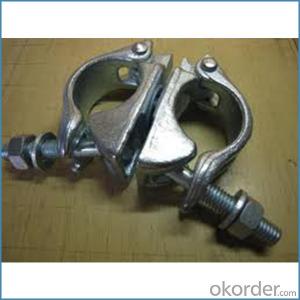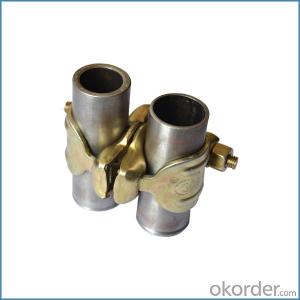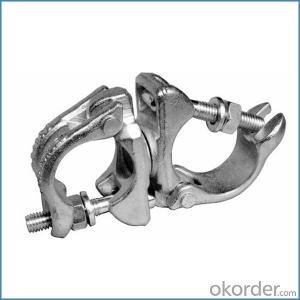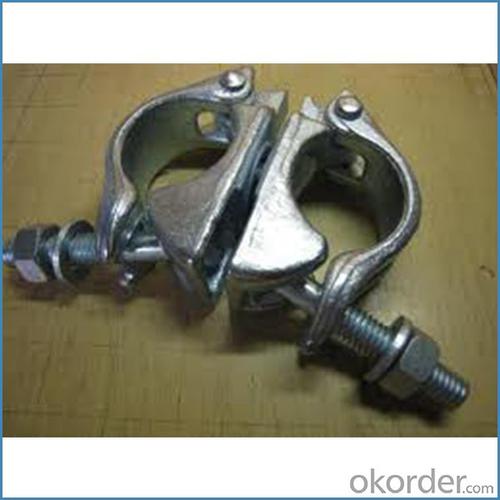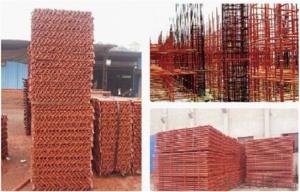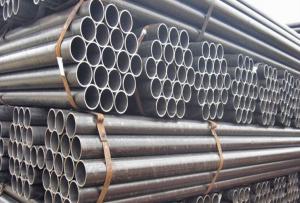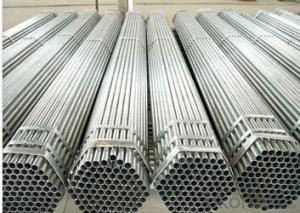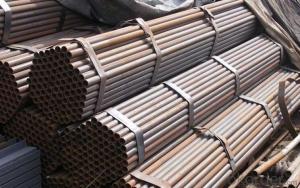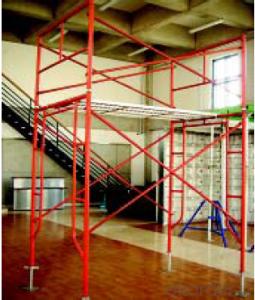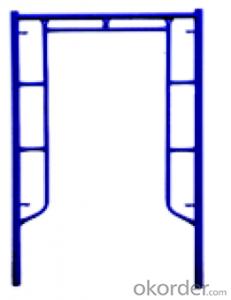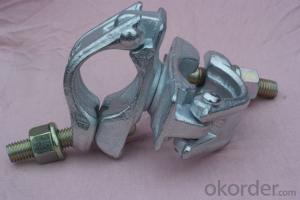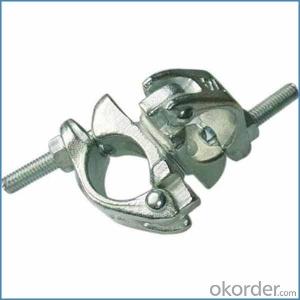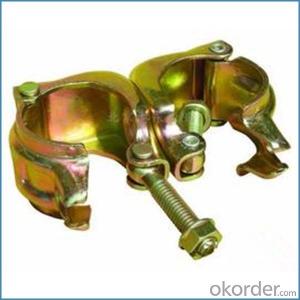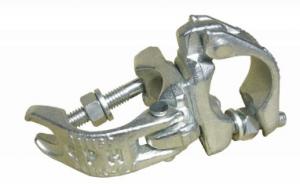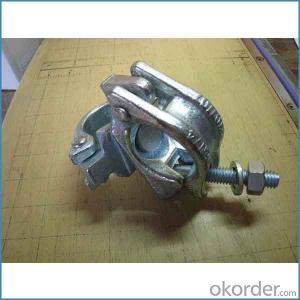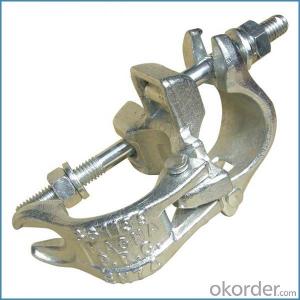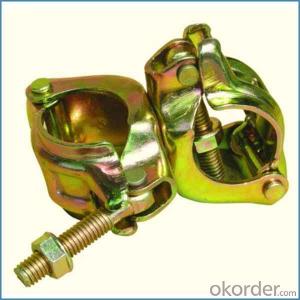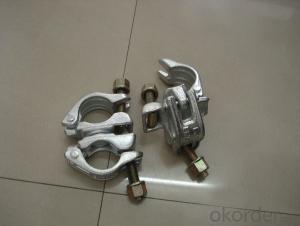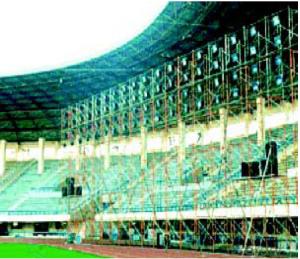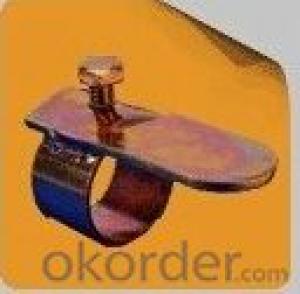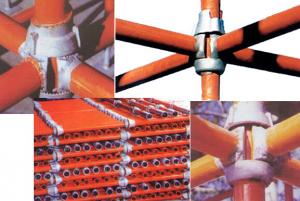Drop Forged Swivel Coupler British Type for Sale
- Loading Port:
- Tianjin
- Payment Terms:
- TT OR LC
- Min Order Qty:
- 100 kg
- Supply Capability:
- 100000 kg/month
OKorder Service Pledge
OKorder Financial Service
You Might Also Like
Drop Forged Swivel Coupler British Type
Description
1.The scaffolding coupler is always used to connect the steel pipe as scaffolding system.
2.The often used coupler is swivel coupler and righ angle coupler .
3.We can provide types of scaffolding coupler according to your requirement.
4.Couoler can fix the 48.3mm scaffolding steel pipe tightly and make the whole scaffolding system more steadily.
5.Material:Q235 steel
6.Overall Size:48.3mm*48.3mm
7.Surface Finish: Galvanized/ Painted
8.Standard:BS1139,EN74
9.Package:25pcs/bag
10.Manufactuering as per customer requirements
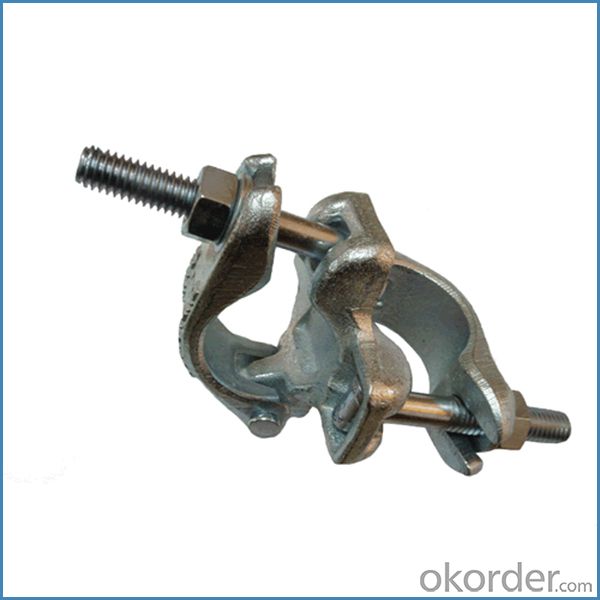
Feature
(1)Excellent Anti-Breaking—Cold Pressed Steel
(2)Outstanding Resistance Deformation
(3)Strong Anti-Dropping Ability
(4)Longtime USe
(5)Qualtity Guaranteed
(6)OEM Service
Photo
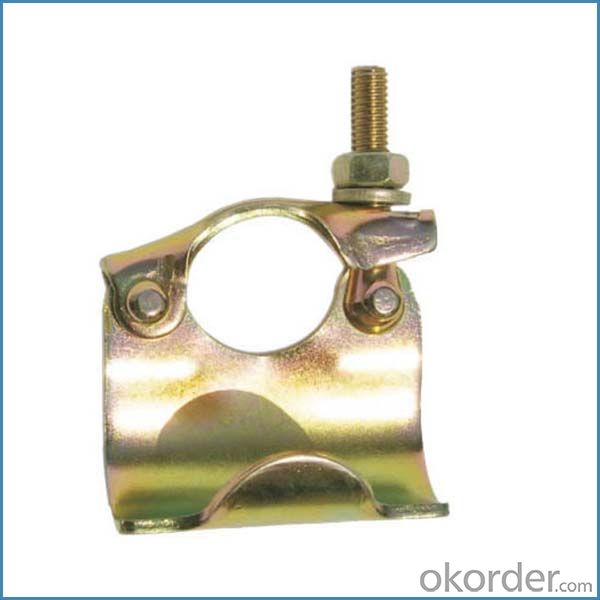
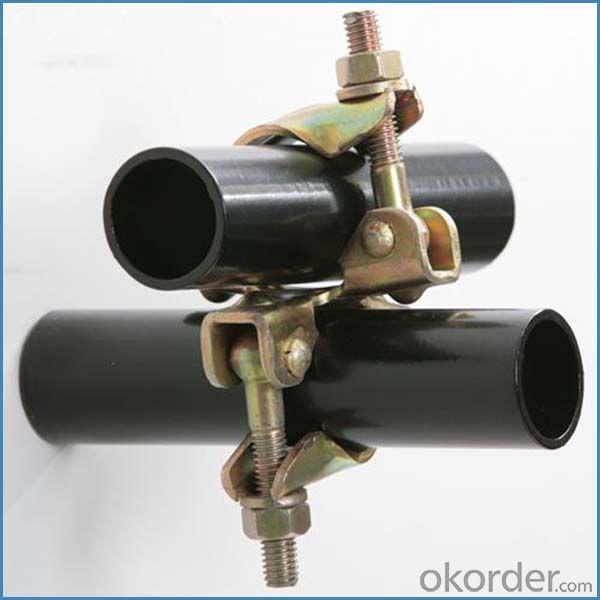
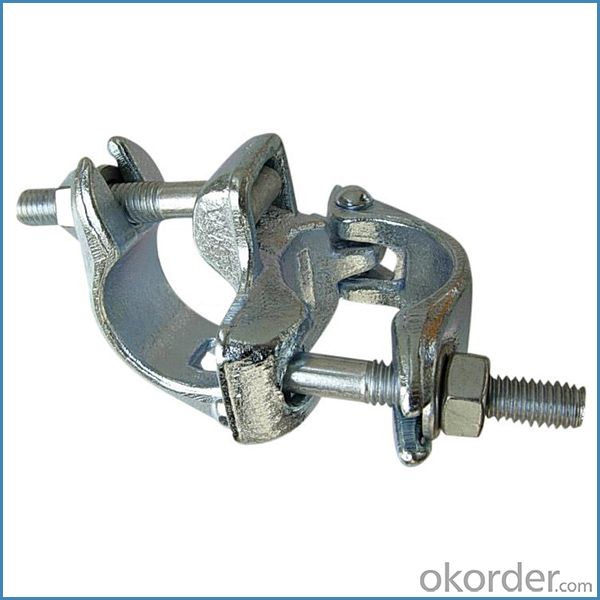
Parameter
| Material | Q235,345steel |
| Size | 48.3mm*48.3mm |
| Surface finish | Galvanized |
| Weight | 1.1kg around |
| Standard | BS1139,EN74 |
| Package | 25pcs/bag,steel pallet |
| Manufacture | As per customer requirement |
| Market | Africa, South America, the Middle East and Asia |
FAQ
Q: Are you a factory or trading company?
We are a state-owned corporation in China,dealing with various kinds of building materials.We have our holding subsidiaries.
Q: Where is your factory located? How can I visit there?
Our factory is located all around China.
Q: Can I get some samples?
Sample is free, customer only pay freight for the first time.
Q: Delivery?
10-30days. (5-15 containers)
Any question,feel free to contact us.
- Q: What are the load capacities of different types of steel tube couplers?
- The load capacities of different types of steel tube couplers can vary depending on their design, size, and material composition. However, it is important to note that load capacities are typically provided by the manufacturer and can be specific to each individual product. In general, steel tube couplers are designed to provide a secure and reliable connection between steel tubes in various applications such as scaffolding, construction, and engineering projects. These couplers are often used to join tubes together to create a stable and load-bearing structure. Load capacities for steel tube couplers can be determined through rigorous testing and analysis by the manufacturer. The capacity is usually expressed in terms of the maximum load that the coupler can safely withstand without failure or deformation. This load capacity is often specified in terms of either a maximum allowable load or a maximum allowable torque. The specific load capacities of steel tube couplers can vary depending on factors such as the type of coupler, its size, and the material from which it is made. For instance, couplers made from higher-grade steel alloys may have higher load capacities compared to those made from lower-grade materials. To determine the load capacity of a specific steel tube coupler, it is recommended to refer to the manufacturer's specifications or consult with a structural engineer or technical expert. These experts can provide accurate and reliable information on load capacities based on the specific requirements and conditions of the project or application.
- Q: Are steel tube couplers compatible with scaffolding systems that require different tube diameters?
- No, steel tube couplers are not compatible with scaffolding systems that require different tube diameters.
- Q: How do steel tube couplers contribute to the overall cost-effectiveness of scaffolding systems?
- Several factors contribute to the overall cost-effectiveness of scaffolding systems, and steel tube couplers play a crucial role in this regard. To begin with, the durability and longevity of steel tube couplers are remarkable. Crafted from top-notch steel, they offer unparalleled strength and stability to the scaffolding structure. This robustness ensures that the system can withstand heavy loads and endure harsh weather conditions, thereby reducing the need for frequent repairs or replacements. As a result, maintenance and replacement costs associated with scaffolding systems are considerably minimized, making them more cost-effective in the long run. Moreover, the versatility of steel tube couplers allows for easy adjustments and reconfigurations to suit the specific requirements of different projects. This flexibility eliminates the necessity of purchasing additional components or materials, resulting in significant time and cost savings. It facilitates swift assembly and disassembly of the scaffolding system, thereby reducing labor costs and increasing productivity on construction sites. Another significant aspect contributing to cost-effectiveness is the ability to reuse steel tube couplers. These couplers can be effortlessly dismantled and repurposed in various projects, thereby reducing overall material costs. This reusability not only saves money but also reduces waste and promotes sustainability within the construction industry. Furthermore, steel tube couplers ensure a secure and sturdy connection between scaffold tubes, guaranteeing the safety of workers on-site. By minimizing the risk of accidents and injuries, scaffolding systems equipped with steel tube couplers help avoid potential legal liabilities and associated costs. In conclusion, the utilization of steel tube couplers in scaffolding systems yields numerous cost-effective benefits. These include durability, versatility, reusability, and safety. With reduced maintenance and replacement costs, saved time and labor, enhanced sustainability, and mitigated legal liabilities, incorporating steel tube couplers is undoubtedly a wise investment that leads to long-term cost savings.
- Q: Can steel tube couplers be used for both residential and commercial scaffolding applications?
- Steel tube couplers are suitable for both residential and commercial scaffolding applications. These versatile and robust connectors are commonly utilized in the construction sector to join scaffolding tubes together. By ensuring a secure and dependable connection, they guarantee the stability and safety of the scaffolding structure. Steel tube couplers can effectively be used in a range of scaffolding applications, including residential projects such as home renovations and larger commercial construction sites. Their design enables them to withstand heavy loads, making them ideal for both residential and commercial scaffolding requirements.
- Q: Can steel tube couplers be used in scaffolding projects that require temporary access or temporary platforms?
- Yes, steel tube couplers can be used in scaffolding projects that require temporary access or temporary platforms. Steel tube couplers provide a secure and reliable connection between scaffolding tubes, allowing for the construction of stable and sturdy temporary structures.
- Q: What is the difference between a putlog coupler and a right-angle coupler?
- A putlog coupler is used to connect a putlog or transom tube to a ledger or standard tube at a right angle, allowing for horizontal bracing in scaffolding systems. On the other hand, a right-angle coupler is used to connect two scaffold tubes at a right angle to create a corner or perpendicular joint. Essentially, the difference lies in the specific purpose and configuration of the couplers in scaffolding construction.
- Q: Can steel tube couplers be used for scaffolding structures that need to provide access to confined or restricted areas?
- Yes, steel tube couplers can be used for scaffolding structures that need to provide access to confined or restricted areas. Steel tube couplers are versatile and can be easily connected and disconnected, allowing for flexible and customized scaffolding configurations. Additionally, their strength and durability make them suitable for supporting workers and materials in confined spaces or restricted areas where access may be challenging.
- Q: Engineering construction safety aspects of the norms of which? Which set of standards in the artificial digging wall related content? Please list, thank you
- Double row scaffolding As the name suggests, is a two rows of independent pole through a small bar, large crossbar and other components connected together with the temporary load frame body, common with fastener steel scaffolding, bowl button scaffolding, etc It is the most common form of building construction Full scaffolding is common in the indoor template support, usually in the plane projection for the matrix, in the case of the upper load to determine the relevant calculation to determine its vertical erect spacing, cross bar step to ensure the carrying capacity of the frame
- Q: What are the key factors to consider when selecting steel tube couplers for a scaffolding project?
- When selecting steel tube couplers for a scaffolding project, there are several key factors that should be considered. These factors include: 1. Strength and Load Capacity: It is important to choose steel tube couplers that are strong enough to handle the anticipated load of the scaffolding structure. This includes considering both the weight of the workers and any equipment or materials that will be placed on the scaffolding. 2. Compatibility: It is crucial to ensure that the steel tube couplers are compatible with the specific type and size of scaffolding tubes being used. Compatibility issues can lead to instability and compromise the safety of the scaffolding structure. 3. Safety Standards and Regulations: It is essential to select steel tube couplers that meet the safety standards and regulations set by the relevant authorities. This ensures that the scaffolding structure is safe and compliant with legal requirements. 4. Durability and Corrosion Resistance: Steel tube couplers should be durable to withstand the demands of the scaffolding project. Additionally, considering the environmental conditions at the worksite is important, as couplers that are resistant to corrosion can prolong the lifespan of the scaffolding structure. 5. Ease of Assembly and Disassembly: Selecting steel tube couplers that are easy to assemble and disassemble can save time and effort during the scaffolding project. Couplers that have user-friendly features, such as quick-release mechanisms, can make the installation and removal process more efficient. 6. Reusability and Cost-effectiveness: Considering the reusability of steel tube couplers can have a significant impact on the overall cost-effectiveness of the scaffolding project. Couplers that can be easily reused for future projects can help reduce expenses in the long run. 7. Supplier Reputation and Support: It is important to select steel tube couplers from a reputable supplier who offers reliable customer support. This ensures that any issues or concerns during the project can be addressed promptly, minimizing downtime and maximizing productivity. By considering these key factors, one can make an informed decision when selecting steel tube couplers for a scaffolding project, ensuring the safety, durability, and efficiency of the scaffolding structure.
- Q: I really want to get my Scaffold done, I've a very very low pain tolerance. i have my tongue done and cried a lil getting it done, and it bled quite alot. i cant stand if it takes too long for the piercing to be done, any one who's got it done plz tell me if it hurts and how its done??? x
- oooo i think it wud hurt quite abit so ask them to numb it 4 ya.
Send your message to us
Drop Forged Swivel Coupler British Type for Sale
- Loading Port:
- Tianjin
- Payment Terms:
- TT OR LC
- Min Order Qty:
- 100 kg
- Supply Capability:
- 100000 kg/month
OKorder Service Pledge
OKorder Financial Service
Similar products
Hot products
Hot Searches
Related keywords
